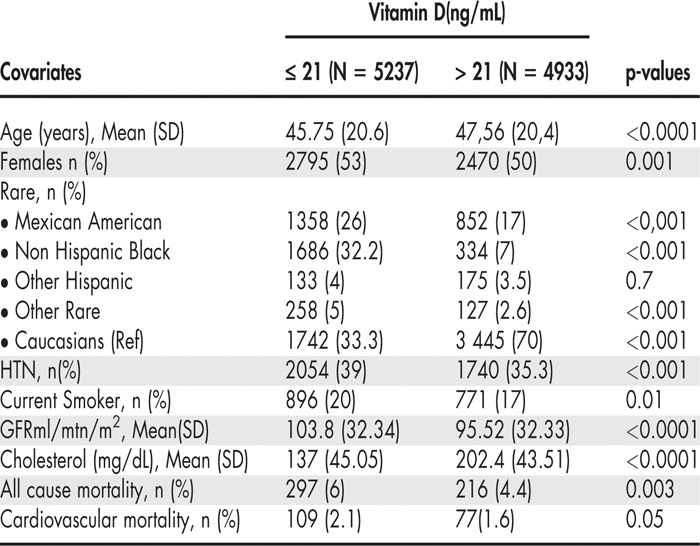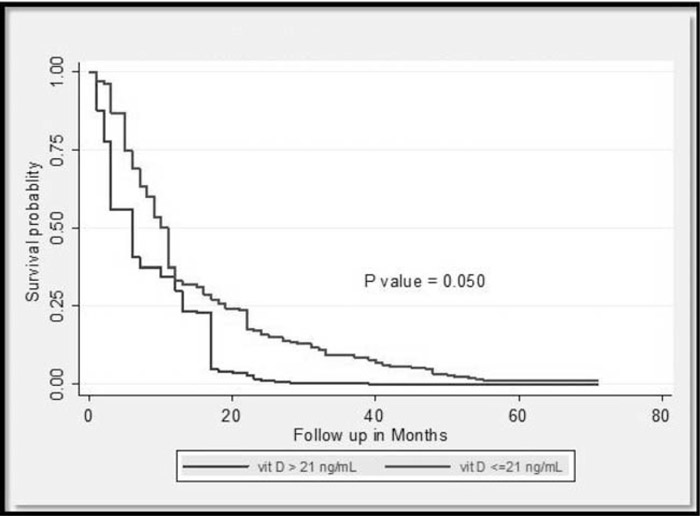Background:
Observational studies have reported significant protective associations between 25‐hydroxyvitamin D [25(OH) D] and all‐cause and cardiovascular (CV) mortality. We believe that these associations have nonlinear relationships and 25(OH) D probably offers greater protection at lower serum levels. To study this hypothesis, we examined the relationship between 25(OH) D and all‐cause and CV mortality in a healthy adult U.S. population.
Methods:
We used data from the continuous National Health and Nutrition Examination Survey (NHANES), a probability sample of noninstitutionalized civilians for the years 2001–2004 (baseline). Data on mortality status were obtained from NHANES linked (National Death Index) mortality files, with follow‐up information from date of survey participation to December 2006. Analysis was limited to individuals older than 18 years. If needed, variables were log‐transformed to meet assumptions of residual normality. To examine the nonlinear relationship of 25(OH) D with all‐cause and CV mortality, we used a spline, with single knot at median serum levels (21 ng/mL) of 25(OH) D. The effect of 25(OH) D was calculated for every 10‐unit increase below and above spline. Cox proportional regression models were used to estimate the hazard ratio (HR) and 95% confidence interval (CI) for all‐cause and CV mortality.
Results:
There were 509 all‐cause and 184 CV‐related deaths during the median (range) follow‐up of 4 years (3–5 years). Of the 10,170 participants, 52% were female, 51% were white, 16.4% were current smokers, and 37% had hypertension. Mean (SD) age and 25(OH) D levels were 46.6 (20.5) and 22 (9.2), respectively. In the univariate regression, we found a statistically significant association between all‐cause mortality and 25(OH) D below (HR, 0.59; 95% CI, 0.45–0.77) but not above its median serum levels (HR, 0.83; 95% CI, 0.65–1.06). In the multivariable model, the association between all‐cause mortality and 25(OH) D below its median remained significant (HR, 0.55; 95% CI, 0.4–0.82). Similarly, in univariate regression, we observed a significant association between CV mortality and 25(OH) D below (HR 0.56, 95% CI 0.4‐0.8) but not above its median (HR, 0.91; 95% CI, 0.56–1.5). In the multivariable‐adjusted model, 25(OH) D retained its significant association with CV mortality below its median (HR, 0.53; 95% CI, 0.3–.93), whereas it conferred no protection for CV mortality above its median serum levels (HR, 0.89; 95% CI, 0.52–1.53).
Conclusions:
The protective relationships between 25(OH) D and all‐cause and CV mortality are nonlinear. In addition, we found that serum 25(OH) D levels above 21 ng/mL appear to offer no protection against all‐cause and CV mortality in both simple and multivariable‐adjusted models in a healthy adult U.S. population.
Disclosures:
M. Amer ‐ none; M. Bakht ‐ none; R. Qayyum ‐ none


